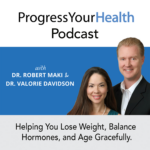
The most common test for thyroid is the TSH, which stands for Thyroid Stimulating Hormone. Unfortunately, this is also the only test most conventional doctors use to screen for thyroid disease.
If the TSH is elevated (above 4.5 mIU/L), you are hypothyroid, and if the number is low (below 0.45 ng/dL), you are hyperthyroid. Yes, this is a bit hard to understand because it is the opposite of what we could expect. High means low and low means high. It is slightly confusing.
Thyroid issues, in general, are not always black and white. It is not as simple as you are hypothyroid or your not. It is a bit more complicated, especially if someone has positive thyroid auto-antibodies, which we will cover in the next episode.
The lab numbers are certainly important, but so is the patient. One rule we always follow is to treat the patient, not the lab test. The TSH is not the only part of the thyroid function and should be tested along with a Free T4 and the Free T3.
The TSH comes from the brain to signal the thyroid gland to produce or not produce thyroid hormone. If the thyroid gland is underproducing thyroid hormone, then the TSH increases. If the thyroid gland is overproducing, then the TSH decreases. In physiology, this is referred to as a feedback loop.
For example, imagine asking your daughter to pick up her shoes and put them away. If she puts her shoes away, great, you only had to ask once in a normal-tone of voice. But what if she ignores you or doesn’t hear you? You would raise your voice until she puts her shoes away. The TSH does the same thing with an underactive thyroid. The TSH level increases if the thyroid gland is underproducing hormone.
This reference range is huge, and a lot of people fall into a ‘normal’ TSH level. We have been trained that if the TSH level is 2.0 mIu.mL or higher, that person may have low thyroid function. Even the American Association Of Clinical Endocrinologists claim that the TSH levels should be .34 to 2.5 mIu.mL.
The TSH is not the only part of thyroid function. The Free T4 and Free T3 should also be done in order thoroughly evaluate the thyroid function. Keep reading, so I can explain what the Free T4 and Free T3 are.
Thyroxine, which is abbreviated (T4) is the primary hormone that is produced by the thyroid gland. The number 4 is related to the number iodine molecules that are needed to make the hormone.
Thyroxine is very stable and has a long half-life of close to 7 days, but is an inactive hormone and does not have much impact directly on overall body function. Your body converts T4 into T3, which is the most active form of thyroid hormone.
For testing purposes, there is a Total T4 and Total T3 test, which is the respective hormone bound to a carrier protein. Most hormones in the body are transported in the blood via carrier proteins. With our patients, we prefer just to run the ‘Free,” unbound T4 and T3.
Triiodothyronine (T3) is the active form of thyroid hormone. You can have all the T4 in the world, but without T3 you would still have hypothyroid symptoms.
This reference range for free T3 is also huge. Truly, any patient we see with a T3 under 3.0 ng/dL is usually tired, has a slow metabolism, is constipated, has a low mood, has dry skin, and is losing hair. It is best to have a Free T3 level at least above 3.0 ng/dL. A level is between 3.8-4.4ng/dL is optimal for thyroid function.
I consider the T4 like your savings account and the T3 your checking account. We all know it is good to have a nice cushy savings account. However, we also need that checking account, so we can pay bills and buy the things we need to live.
It is the same thing with thyroid hormones; we need an optimal level of T4 (saving and transfer to checking). And we need an optimal amount of T3 to utilize all the great functions thyroid provides for us. The easier and more efficient the transfer is from your savings (T4) to your checking (T3) the better your thyroid will function and the better you will feel.
Approximately 60% of this T4 to T3 conversion occurs in the liver. About another 20% occurs due to the bacteria (microbiome) in your colon. The last approximate 20% is converted by body tissues such as your muscles.
Reverse T3 is an inert, inactive thyroid hormone. We usually only test this in patients currently taking Synthroid, Levoxyl or Levothyroxine. All of these medications as a class are referred to as T4 monotherapy.
These medicines only contain T4, and the body needs to convert the T4 into T3 by removing an iodine molecule. If the dosage of the medication is too high, then the body shifts to converting T4 into Reverse T3, which competes with T3.
Also in Hashimoto’s or a starvation/caloric restriction diet, the Free T4 will not convert to Free T3 and instead to RT3. More Reverse T3 and less Free T3 will cause the person to have more hypothyroid symptoms. We will dive into both Hashimotos and caloric restriction on future episodes.
The post What Are The Best Blood Tests for Thyroid Function? | PYHP 019 appeared first on .
Discover the common and unfamiliar symptoms that you might be experiencing. Get access to cases of real women with hormonal conditions.

In this episode, we return to a listener’s question regarding thyroid dosing in perimenopause. In our previous episode, we answered Tracy’s question about taking estrogen in perimenopause. Tracy also asked us an additional question about her thyroid doses. Tracy does not have a thyroid gland and has been noticing her dose is continually increasing as […]
In this episode, we discuss a listener’s question regarding perimenopause and estrogen hormone replacement. Tracy is concerned because she is still having a period but also has symptoms of low estrogen. She is not sure if she is a candidate for estrogen therapy since she is still cycling. Tracy’s Question: Hi- you’ve discussed in past […]
In this episode we discuss Jenell’s question she submitted on our website (Ask the Dr). Jennell has been having terrible anxiety since entering menopause and it is really affecting her quality of life. Jenell’s Question: Since starting menopause, I’ve had debilitating anxiety, especially bad in the morning. By evening, It practically goes away. I’m 54 […]
In this episode, we discuss a listener’s question. Amanda is 50 years old and starting to have menopausal hot flashes and weight gain. However, she is most concerned about the heart palpitations she is having. Amanda has had a cardiovascular workout and does not have heart disease. Most people might not be aware, but feeling […]
In this episode, we discuss a listener’s question about perimenopause. ‘Maggie’ is in her 40’s and experiencing severe insomnia with anxiety. She has tried supplements and different doses of progesterone with minimal results. She is having so many ups and downs with her insomnia, anxiety, and hormones. She is wondering how long this is going […]
In this episode, we talk about Mary’s hormone concerns after ovarian failure. She is only 34, and in the last 7 years since her ovarian failure has tried many hormone replacement options, all without the success she was looking for. Let’s Read Mary’s Question: When I was 27 years old I was diagnosed with iatrogenic […]